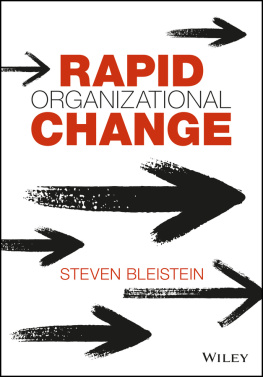COVERT Processes at Work
Managing the Five Hidden Dimensions of Organizational Change
ROBERT J. MARSHAK
BERRETT-KOEHLER PUBLISHERS, INC.
San Francisco
Covert Processes at Work
Copyright 2006 by Robert J. Marshak
All rights reserved. No part of this publication may be reproduced, distributed, or transmitted in any form or by any means, including photocopying, recording, or other electronic or mechanical methods, without the prior written permission of the publisher, except in the case of brief quotations embodied in critical reviews and certain other noncommercial uses permitted by copyright law. For permission requests, write to the publisher, addressed Attention: Permissions Coordinator, at the address below.

Berrett-Koehler Publishers, Inc.
235 Montgomery Street, Suite 650
San Francisco, California 94104-2916
Tel: (415) 288-0260, Fax: (415) 362-2512
www.bkconnection.com
Ordering information for print editions
Quantity sales. Special discounts are available on quantity purchases by corporations, associations, and others. For details, contact the Special Sales Department at the Berrett-Koehler address above.
Individual sales. Berrett-Koehler publications are available through most bookstores. They can also be ordered directly from Berrett-Koehler: Tel: (800) 929-2929; Fax: (802) 864-7626; www.bkconnection.com
Orders for college textbook/course adoption use. Please contact Berrett-Koehler: Tel: (800) 929-2929; Fax: (802) 864-7626.
Orders by U.S. trade bookstores and wholesalers. Please contact Ingram Publisher Services, Tel: (800) 509-4887; Fax: (800) 838-1149; E-mail: customer.service@ingrampublisherservices.com; or visit www.ingrampublisherservices.com/Ordering for details about electronic ordering.
Berrett-Koehler and the BK logo are registered trademarks of Berrett-Koehler Publishers, Inc.
First Edition
Paperback print edition ISBN 978-1-57675-415-3
PDF e-book ISBN 978-1-57675-795-6
IDPF ISBN 978-1-60994-334-9
2008-1
Design and production: Detta Penna
Copyediting: Judith Johnstone
Indexing: Joan Dickey
Cover design: Karen Marquardt
Cover image 2006 Inmagine/JupiterImages Corporation
To Allison,
who helped me see above-the-clouds.
ix
Foreword
The existence of covert processes has been known for a long time. Whether we called them hidden agendas, unconscious desires, the elephant under-the-table, latent functions, or shared tacit assumptions, we knew they were there but rarely had a clear idea what to do about them.
For the therapist, the challenge has typically been how to bring the covert to the surface in a helpful way. For the group therapist or team leader, the complication was how to make members aware that they not only carried individual hidden agendas but also that the group itself evolved covert assumptions that guided and constrained its behavior to an unknown degree. For the negotiator or diplomat, the existence of covert intentions was taken for granted as intrinsic to the process of reaching agreement; diplomacy lay in knowing how to make the covert known without actually revealing it directly or at the wrong time.
In the human relations and organization development movement, there was a period when openness was taken almost as an absolute valuelet it all hang out, it will be good for you. Giving feedback, telling people what we thought of them, was thought to improve relations and task accomplishment. But the introduction of sensitivity training into organizations soon showed that some kinds of openness were not welcome. We discovered that social norms about what to say and not say to each other could not be subverted without some undesirable consequences. Etiquette, tact, and politeness often required keeping covert things covert. But we also knew that covert processes strongly influenced the outcomes of social action, often in a negative way, so we could not simply ignore them.
I mention all of these issues and unresolved dilemmas because in this book we finally have a coherent approach to all of them. Not only does Bob Marshak provide under one cover an inventory of individual, group, and organizational covert processes, but he also provides ways of x assessing them and dealing with them. This should be particularly useful to organizational consultants and managers because it makes us realize that in all social interaction there are multiple covert processes operating. How we deal with them will obviously vary with the situation and there are no formulas for dealing with the covert, but if we cannot identify and perceive their operation we cannot deal with them at all. The reader will appreciate the many insights that this book provides.
Edgar H. Schein
xi
Preface
This is a book about powerful processes that impact organizations but usually remain unseen, unspoken, or unacknowledged. Collectively called covert processes, they include hidden agendas, blind spots, organizational politics, the elephant in the room, secret hopes and wishes, tacit assumptions, and unconscious dynamics.
Although covert in their workings, these processes can be insidious in their impacts, often shaping outcomes without our fully realizing it. One of my earliest encounters with covert processes at work was during a meeting between the heads of two divisions. The meeting had been called to resolve conflicts over responsibilities and to establish greater collaboration between the two divisions. I was there in a staff role to follow up on any agreements that came out of the discussions. The two division heads greeted each other in friendly terms and exchanged jokes and pleasantries. Eventually they each acknowledged that there were disagreements and difficulties that were creating problems. After about an hour, they smiled at each other, shook hands, and got up to leave. Even though I was not supposed to speak, I blurted out, But what are you going to do about the issues? You didnt agree to anything. The division heads both looked at me, said nothing, and walked out of the room. After they left, one of the other people in attendance turned to me and said, They cant stand each other. This may have been one of my earliest encounters with covert processes at work, but it certainly was not my last. In more than thirty years as a staff specialist, executive, and organization change consultant I have witnessed the impacts of many types of covert processes on a daily basis.
Purpose
My experiences with covert processes, especially during organizational change, led me to inquire more deeply into their causes and manifestations xii and to try out different ways to identify and address them. It also led to developing and facilitating for many years with my colleague Judith H. Katz a training program called the Dealing with Covert Processes Workshop. During the workshops we had opportunities to work with participants from all types of organizations, and to test and refine our insights and ideas about covert processes. Furthermore, despite the routine warnings in management textbooks that what is overt in organizations is only the tip of the iceberg, I also discovered that with a few exceptions (e.g., Egan, 1994) there was little guidance available on how to deal with the unseen aspects of the iceberg. All of this convinced me that a manual to help change leaders, staff specialists, and consultants better understand, recognize, and manage the covert processes that could undermine their change efforts would be a useful contribution.











